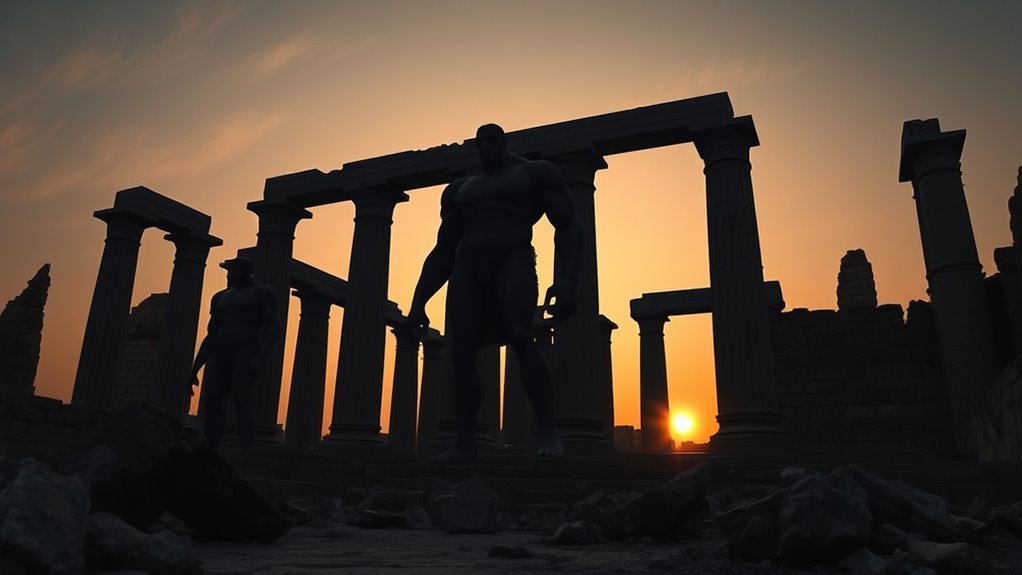The Nephilim are mysterious giants mentioned in biblical texts, often believed to be the offspring of divine beings or fallen angels and humans. They symbolize chaos, strength, and divine rebellion across various cultures and legends. Some see them as literal beings, while others interpret them as mythological or symbolic figures representing human fears and hubris. If you’re curious, you’ll discover how these ancient stories continue to influence beliefs and stories today.
Key Takeaways
- The Nephilim are biblical giants mentioned in Genesis 6:1-4, believed to be offspring of “sons of God” and “daughters of men.”
- They symbolize chaos, divine rebellion, or fallen angels, with interpretations varying across religious and mythological traditions.
- Some theories suggest they were fallen angels, while others view them as ancient human giants or mythic beings.
- Archaeological and scientific evidence for the Nephilim’s existence remains inconclusive and debated among scholars.
- They have influenced cultural depictions of giants and fallen beings throughout history, from biblical texts to modern fiction.
The Biblical Origins of the Nephilim

Have you ever wondered where the Nephilim come from in the Bible? Their origins are rooted in Genesis 6:1-4, where they are described as the offspring of the “sons of God” and the “daughters of men.” Many interpret this passage as a symbol of divine-human interaction, with Nephilim symbolism representing power, chaos, or even fallen angels. These biblical references have fueled modern interpretations that see the Nephilim as giants or supernatural beings. Their presence in early scripture hints at ancient fears and beliefs about divine interference with humanity. Understanding the biblical origins helps you see how these figures have been woven into cultural narratives, inspiring countless theories and interpretations about their true nature and significance.
Theories About Their Identity and Nature
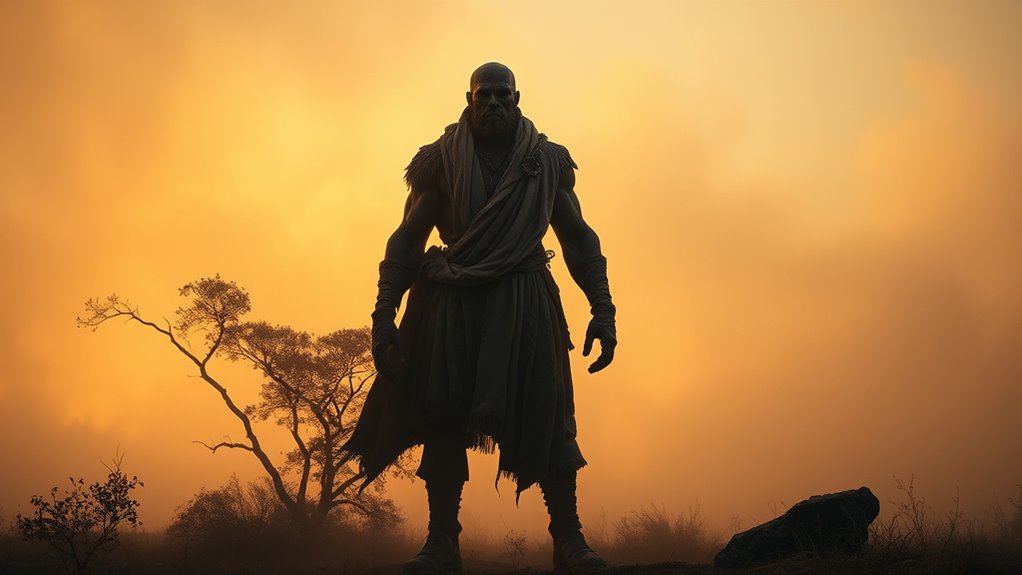
Many scholars and enthusiasts have proposed various theories to explain the true nature of the Nephilim, reflecting the complex ways people have interpreted these mysterious beings. Some believe they symbolize chaos and divine punishment, linking them to Nephilim symbolism that emphasizes their hybrid nature. Others see the Nephilim as Giants in mythology, representing primal strength or ancient ancestors. These ideas suggest they might be fallen angels, ancient warriors, or mythical giants. To visualize these theories:
| Theory | Explanation |
|---|---|
| Fallen angels | Nephilim as heavenly beings cast out |
| Mythical giants | Giants in mythology, symbolizing power |
| Hybrid beings | Part divine, part human, embodying duality |
Understanding these theories helps you grasp the diverse interpretations surrounding their identity.
The Nephilim in Ancient Texts and Legends
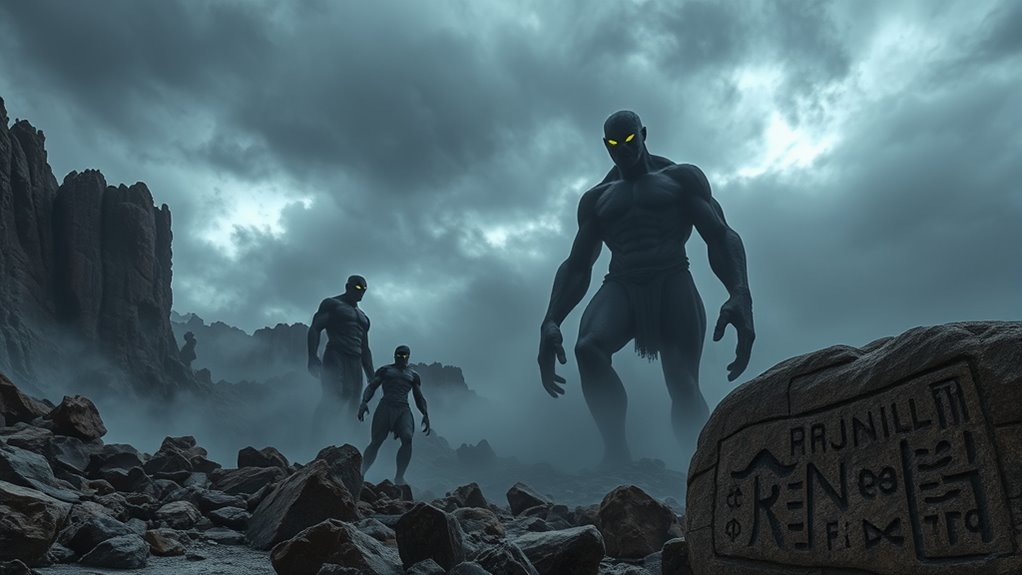
Ancient texts and legends offer a variety of stories about the Nephilim, revealing how different cultures viewed these mysterious beings. Biblical references suggest they were giants or fallen angels, but other traditions interpret them differently. Exploring their symbolism and mythological roles helps uncover how humanity has understood these enigmatic figures across history.
Biblical References and Interpretations
The Nephilim are referenced in several biblical passages, most prominently in Genesis 6:1-4, where they are described as the offspring of the “sons of God” and the “daughters of men.” These enigmatic beings have sparked numerous interpretations, with some scholars viewing them as giants, fallen angels, or ancient kings. In biblical context, the Nephilim symbolism often points to beings of extraordinary size and power, aligning with the idea of ancient giants. Some interpret these references literally, imagining them as towering, supernatural figures, while others see them as mythological symbols representing chaos or divine rebellion. Regardless of interpretation, the biblical texts highlight their significance as mysterious, impactful beings whose origins continue to fascinate and puzzle readers.
Legends Across Cultures
Have you ever wondered how stories of giants and mighty beings appear across different cultures? In ancient legends worldwide, mythical giants often symbolize power and chaos. For example, Greek mythology features Titans—massive beings defeated by gods—highlighting themes of rebellion and divine authority. In Norse legends, Jotunn or frost giants embody primal forces of nature. Similarly, in Mesopotamian stories, mythic giants appear as formidable adversaries or divine messengers. These ancient legends reflect humanity’s fascination with enormous, supernatural beings that challenge the natural order. Although details vary, the recurring presence of mythical giants across cultures suggests a shared cultural impulse to explain the unknown and embody universal fears and aspirations. These stories link to the Nephilim, hinting at a broader human tendency to mythologize mighty, otherworldly beings.
Symbolism and Mythology
Stories of giants and mighty beings often serve as symbols of chaos, power, and the unknown in various cultures. These mythic symbols embody themes of divine intervention, human fears, and the struggle between order and chaos. In ancient texts and legends, the Nephilim represent more than just fallen giants; they symbolize the crossing of boundaries—between mortal and divine, chaos and order. Their presence carries cultural significance, reflecting society’s understanding of power, rebellion, and the mysteries of creation. These stories help you grasp how civilizations used mythic symbolism to explain natural phenomena, divine justice, or moral lessons. The Nephilim’s mythic symbolism continues to influence modern interpretations of ancient legends, highlighting their enduring role in human storytelling and cultural identity.
Possible Origins: Fallen Angels or Human Giants
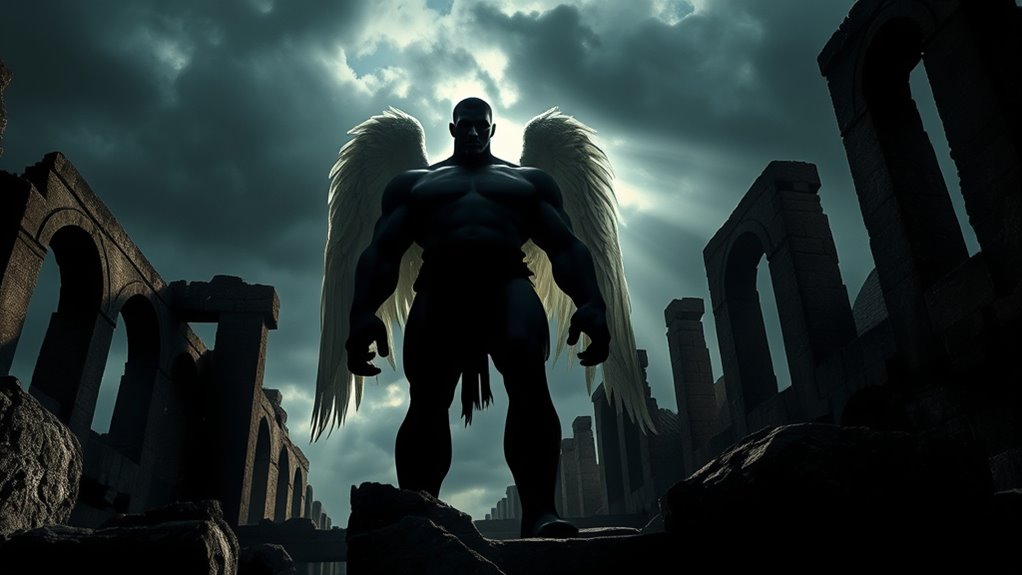
You might wonder if the Nephilim were fallen angels or human giants, and the evidence isn’t clear-cut. Some texts suggest celestial beings mated with humans, while others point to enormous humans as the source. Which explanation aligns better with the available evidence?
Angelic Beings or Humans?
The origins of the Nephilim have long sparked debate, with some suggesting they were angelic beings fallen from grace, while others argue they were merely humans—giants born from extraordinary circumstances. If you consider angelic beings, they’re often linked to angelic hierarchies, implying a structured divine order. These beings might have descended, blending with human women, creating the legendary Nephilim. Conversely, some believe the Nephilim were human giants, born from remarkable genetics or environmental factors. This dual view leads to a fascinating comparison:
| Angelic Beings | Humans |
|---|---|
| Fallen from grace | Giants born naturally |
| Part of angelic hierarchies | Result of extraordinary circumstances |
| Might have interacted with humans | Fully human origins |
| Supernatural origins | Natural giants |
Myth vs. Evidence
Debate over the origins of the Nephilim hinges on both myth and evidence, with skeptics pointing to a lack of concrete proof for supernatural involvement and proponents citing ancient texts and archaeological findings. The Nephilim origins are often linked to mythological symbolism, representing more than just literal giants or fallen angels. Many argue that these stories reflect cultural themes, religious beliefs, or metaphorical truths rather than physical beings. On the other hand, archaeological discoveries of large human remains and ancient texts describe giants or hybrid creatures, fueling the debate. Ultimately, the myth vs. evidence argument centers on whether these stories are literal history or symbolic narratives. Understanding the mythological symbolism behind the Nephilim helps clarify why interpretations vary so widely.
Archaeological and Historical Perspectives
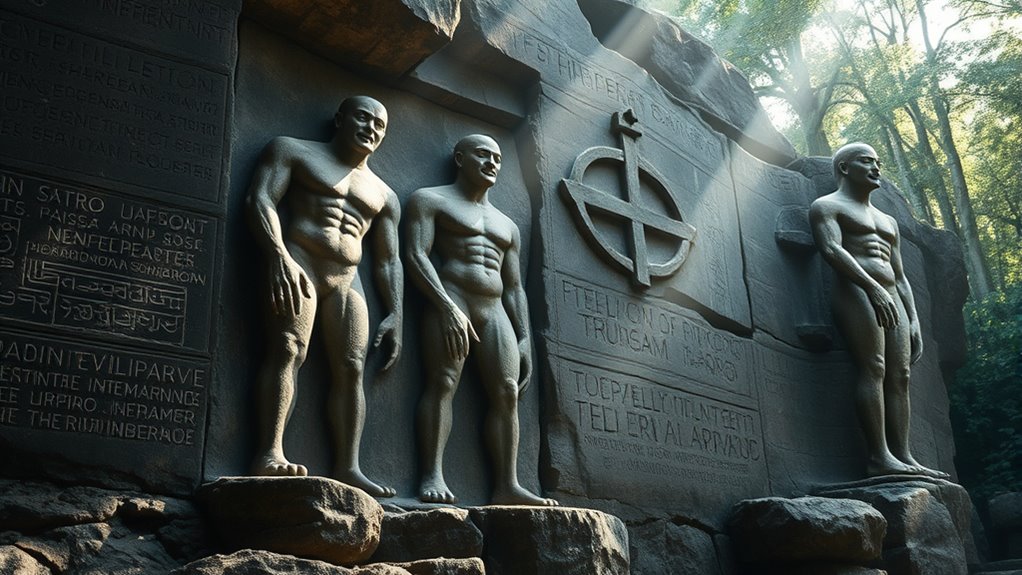
Archaeological and historical evidence offers intriguing, yet often ambiguous, insights into the existence of Nephilim. Some researchers point to alleged Nephilim fossils found in various archaeological sites, claiming these remains suggest giants once roamed the Earth. However, no scientifically verified Nephilim fossils have been discovered. Ancient inscriptions, such as those in Mesopotamian texts or biblical artifacts, mention beings that could be interpreted as giants, fueling speculation about their reality. Nonetheless, these inscriptions are often poetic or symbolic, making definitive conclusions difficult. While these archaeological and historical clues spark curiosity, they remain unconfirmed evidence. The lack of concrete physical proof means that interpretations of these findings are often influenced by cultural or religious perspectives rather than scientific consensus.
Cultural Depictions and Interpretations
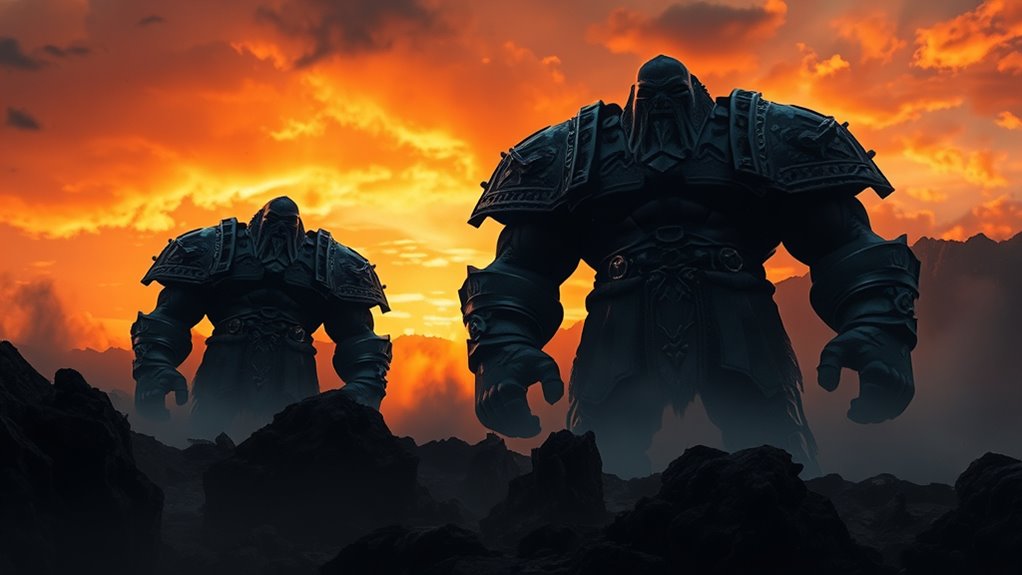
How have cultures throughout history portrayed the Nephilim? Many see them as symbols of chaos, divine rebellion, or human hubris, reflecting their deep Nephilim symbolism. Their cultural impact varies—from biblical texts to modern fiction—shaping perceptions of giants and fallen beings. These depictions influence art, literature, and religious beliefs, highlighting their significance across societies. To understand this better, consider the following table:
| Culture | Nephilim Symbolism | Cultural Impact |
|---|---|---|
| Ancient Israelite | Giants, divine rebellion | Moral lessons, religious themes |
| Medieval Europe | Monsters, fallen angels | Artistic motifs, moral allegories |
| Modern Fiction | Supernatural giants, villains | Popular culture, entertainment |
| Popular Media | Mythical beasts, symbols of chaos | Shaping modern perceptions |
This table illustrates how perceptions of the Nephilim evolve, impacting culture’s view of the divine and the monstrous.
The Symbolism and Significance of the Nephilim

The Nephilim embody complex symbolism that reflects humanity’s deepest fears and aspirations. They represent divine symbolism, embodying the tension between mortal humans and powerful, often divine, beings. Their mythological significance lies in their status as giants, symbolizing chaos, strength, and the unknown. The Nephilim challenge the boundaries between the divine and the earthly, serving as a reminder of the fragile line separating order from chaos. They also symbolize the consequences of forbidden knowledge and hubris, warning of divine retribution. As mythological figures, the Nephilim evoke themes of divine intervention, fallen angels, and the corrupting influence of power. Their presence in ancient texts underscores their role as symbols of divine mystery, human vulnerability, and the perpetual struggle between good and evil.
Modern Interpretations and Ongoing Debates
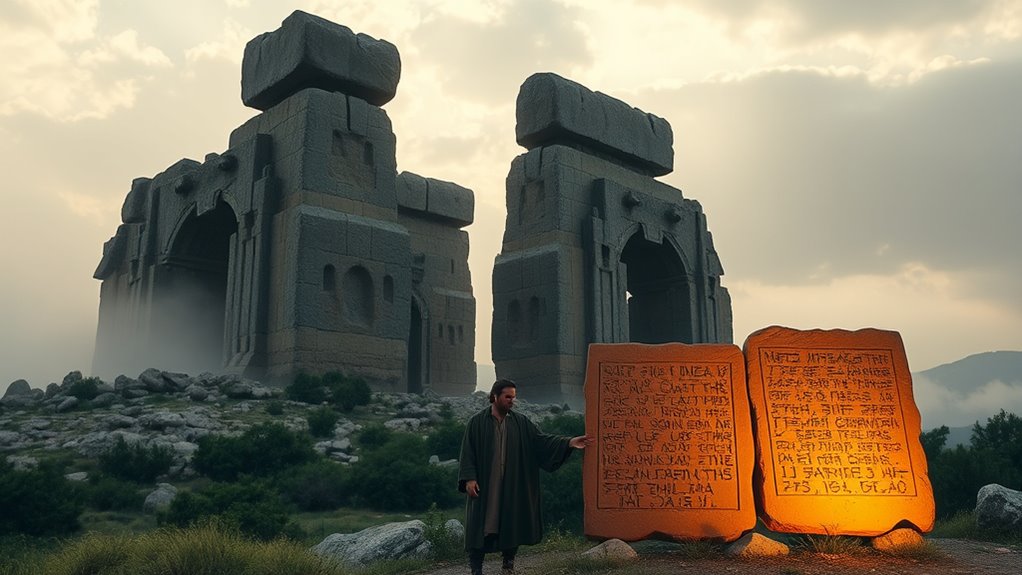
Modern interpretations of the Nephilim continue to spark lively debates, blending ancient symbolism with contemporary perspectives. In modern research, scholars explore different angles to understand their true nature. You might consider:
- The symbolic role of Nephilim in illustrating human-divine interactions and moral lessons.
- How modern archaeological findings influence the perception of these giants.
- The ongoing debate about whether Nephilim were literal beings or allegorical figures.
These discussions highlight how Nephilim symbolism remains relevant today, inspiring diverse theories. Some see them as ancient myth, others as historical giants, while some view them as metaphors for human hubris. As research evolves, so does your understanding of their significance, fueling ongoing debates in biblical studies and archaeology.
Frequently Asked Questions
Are the Nephilim Mentioned in Other Religious Texts Besides the Bible?
You wonder if the Nephilim appear in other religious texts besides the Bible. In ancient mythologies, similar giants or fallen beings appear, often with different names and stories. Modern interpretations sometimes link these figures to the Nephilim, suggesting they symbolize chaos or divine rebellion. While the Bible is the primary source, other cultures’ myths provide comparable stories, enriching the idea that such beings hold universal symbolic significance across various spiritual traditions.
What Physical Characteristics Are Attributed to the Nephilim?
You wonder about the Nephilim’s physical traits, and their image is striking. They’re often described as giants with a gigantic stature, towering over others, and a muscular build that suggests immense strength. The contrast between their formidable size and their mysterious origins sparks curiosity. These descriptions paint a picture of beings who embody both power and mystery, making them some of the most fascinating figures in ancient texts.
Do Any Archaeological Discoveries Definitively Confirm the Existence of Nephilim?
You won’t find any archaeological discoveries that definitively confirm the existence of Nephilim. Ancient artifacts and mythological parallels suggest they might be part of ancient stories or beliefs, but there’s no concrete evidence. While some claim certain relics hint at their existence, these are often speculative. So, until new discoveries emerge, the Nephilim remain a fascinating mythological concept rather than confirmed historical beings.
How Do Different Cultures Interpret the Concept of Giants or Fallen Beings?
You see, different cultures interpret giants or fallen beings through ancient mythologies and cultural symbolism. For example, Greek mythology speaks of Titans as colossal, fallen gods, while Norse legends tell of Jotunn, giants often representing chaos. In many traditions, these beings symbolize primal forces or moral lessons. By exploring these diverse stories, you gain insight into how societies perceive power, chaos, and divine intervention across history.
Are There Modern Groups or Movements That Claim to Identify With the Nephilim?
You might notice modern mythologies and contemporary claims where groups identify with the Nephilim, seeing themselves as descendants or inheritors of their legendary traits. Some believe these beings symbolize strength or divine connection, and they openly promote these ideas through books, websites, and gatherings. These claims often blend ancient stories with new spiritual or cultural narratives, allowing followers to feel linked to a mysterious, powerful past.
Conclusion
So, seeker, the Nephilim remain a mysterious mosaic of myth and history. Their story sparks speculation, stirring stories of giants and fallen angels. Whether woven from wonder or woven into wisdom, their legend lingers long in legends and lore. As you explore these enigmatic entities, remember: questions persist, and curiosity continues. Keep searching, stay skeptical, and let the layers of legend lead you to your own enlightened understanding of these ancient giants.

